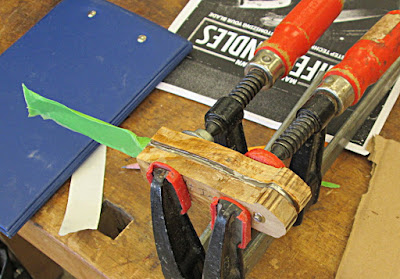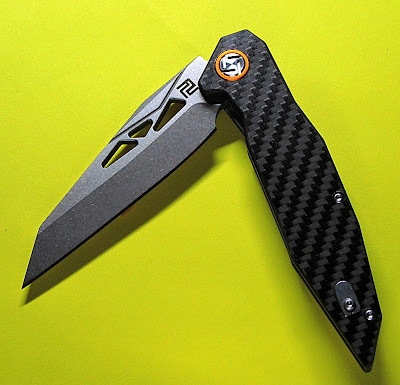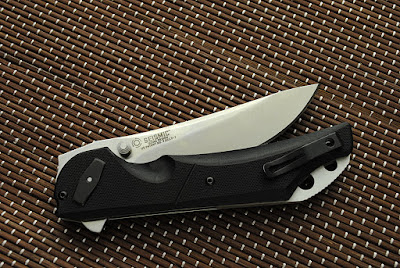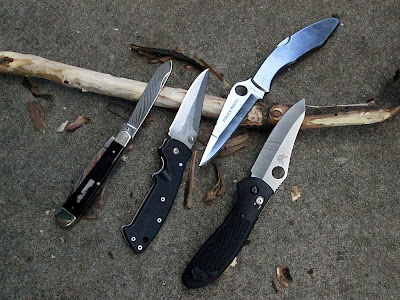There are few knives better known
in the knife community than Spyderco’s Endura and Delica. Introduced in 1990, they have always been in
the top ten sellers at Spyderco. But there is a new contender, the Endela.
 |
| A full serrated Endela flanked by a Delica and Endura. |
Spyderco’s Delica was the first
tactical knife I ever owned. I owned lock
backs prior to a Delica, but never one with a clip or engineered for one-hand
opening. The ability to consistently
open a knife with one hand which would lock open was amazing. From camping to community theater, in fact
any daily activity, these knives made an impact.
Police, fire and military all tended
to carry an Endura or Delica. They were
strong, lightweight (compared to the other popular “tactical carry“ knife of
the time, the Buck 110), easy to open and economical. The steel retained its edge reasonably well
and could be quickly sharpened with the Spyderco Sharpmaker, which I still use. Both knives still retain the properties of
strength, ease of operation and performance.
Long before 9/11 Delicas quickly
found a home with airline travelers. You
simply dropped them in the tray with your car keys and pen, and they were
returned on the other side of the metal detector almost always without a comment.
Even the partial serrations were not of
any real concern. I typically carried
two while my wife carried her Delica. I
use to sit in mid-flight and cut open my in-flight snack. That makes me feel nostalgic.
As a purveyor of edged steel, I am
more than qualified to state the obvious:
No matter how well designed, no knife or series of knives is perfect for
all users. One only has to look at all
the available glove sizes to realize that.
The Delica and Endura are the Baby
and Papa Bear that drunk blonde, Goldie, finds when she breaks in to a fairytale
home in the woods. So what fills that
middle spot? Consumers asked for a
bigger knife that was smaller than the Endura.
Spyderco found an answer, the Endela.
 |
| Daily lab chores, opening packages. The blade was very controllable. |
Let’s do a three way head-to-head
with the new addition to this family of edges, the Endela.
|
Feature
|
Delica
|
Endela
|
Endura
|
|
Open length (inches)
|
7.13
|
8.1
|
8.8
|
|
Blade length (inches)
|
2.88
|
3.4
|
3.8
|
|
Blade thickness (inches)
|
0.09
|
0.12
|
0.13
|
|
Steel
|
VG-10
|
VG-10
|
VG-10
|
|
Grind
|
Saber
|
Flat
|
Saber
|
|
Clip
|
4-position
|
4- position
|
4-position
|
|
Weight
|
2.5 oz.
|
3.1 oz.
|
3.6oz
|
|
Cost (MSRP)
|
$120.00
|
$123.00
|
$125.00
|
As you can see, the Endela looks a
little like the middle child. The blade is
about a half inch larger compared to the Delica, but 0.4 inches smaller that
the Endura. Blade thickness is pumped up
by 0.03 of an inch, but its 0.01 inch thinner than the Endura. You’ll see that trend in the other knife
parameters too. The Endela is a
noticeable step up from the Delica, but almost a twin to the Endura.
Frankly, the Endela seems to be an
answer in search of a question.
The Endela comes only as the flat
grind blade, which seems to be super-hot on with consumers right now. Both the Delica and Endure can be found with similar
flat grinds. Both the Endura and Delica can
be obtained with a plain edge, a partial serration and full serration. The Endela sports either a plain edge or a
full serration.
The full serration has amazing
cutting powers. Packing straps, seat
belts, heavy rope all come clean to its power.
The little defensive edge training I have taken strongly suggests I
don’t want to be cut by a Spyderco serration.
The Endela market, according to Spyderco,
is for those of us who want a larger knife than a Delica, but smaller than an
Endura. Hence the mash-up. Not the most original, but…..
The difference is in the feel and
use. I like the Endela. It feels good in my hand and if I was a first
time buyer, I’d get an Endela.
It will
be interesting to see if it’s in the 2021 catalog.





























